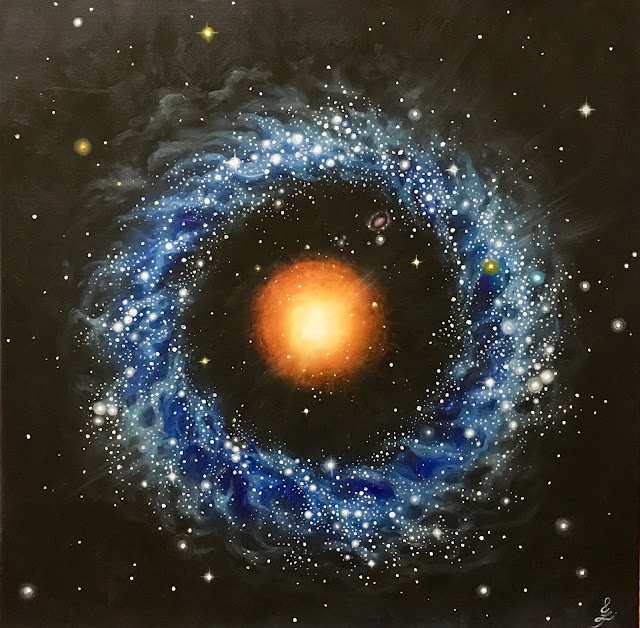Dark energy and the expansion of the Universe:
“Expand the mysterious universe with the astonishment of your observers wanting to know what it is that drives you to be greater than you are and belittling those who already are.”
The knowledge that the human being has of the universe expands in each new era, going from a geocentric and static model of the universe to a heliocentric one with no apparent limits to reach the present time with a universe with titanic dimensions and full of more mysteries than resolutions Even more so, a universe that expands, with every second that 1km of space passes in the cosmos it expands some fifty meters (-0.000000000000001 m), that is, the size of a proton, it may seem very little but over time it makes itself felt and therefore it is evidence that the Universe is very old, an expansion of 13,700 million years, but the question of this expansion is why is the universe expanding? The expansion could be thought of as a relic of the inertia of the Big Bang or a kind of First Great Motor that pushes it to expand at its ends, similar to Aristotle’s First Motor in his cosmological model, but if there is no First Great The gravitational attraction between the galaxies should slow down the expansion little by little, slowing down the expansion, but the truth is that the Universe accelerates in its expansion. To find out, the cosmologists first tried to measure the distance at which very distant galaxies are, because the further away a bright object is, the lower its apparent luminosity, so if the expansion is slowing down, the galaxies should appear to be brighter than if the expansion did not stop, since the light would diffuse in a smaller area when being closer. But the problem with this method is that each galaxy is different and it cannot be guaranteed that they are not very bright because they are too far away or because they emit little light. It wasn’t until cosmologists found a more reliable method: Type Ia supernovae. Finally the problem was solved: galaxies are not slowing down but are accelerating. Given this new evidence of the acceleration of galaxies, shouldn’t they slow down due to the effect of gravitation or is it that gravity is not well understood at great distances? To find a solution, we resort to General Relativity, which argues that space is a dynamic entity that is determined by the density and the type of energy it contains. Is it possible for space to expand rapidly in the Theory of Relativity? Yes, as long as there is a type of energy that acts as a motor, that is hardly diluted with expansion and that dominates the total energy of the Universe.
This type of energy is called Dark Energy, an element that is not diluted unlike baryonic energy ends up dominating in the long run, the larger the Universe gets, the more dark energy there is, and for 7 billion years it has dominated the expansion of the Universe, being 70% of all the energy of the Cosmos.
As enigmatic as dark energy may seem, it turns out that it resembles something that is already known: an energy from the void, intrinsic to space itself. Particle physics knows how to fill that energy gap with the Higgs field or field fluctuations (leptons, quarks and neutrinos), but the problem with taking these theories to the real Universe to explain the presence of the acceleration of the cosmos is that they contribute too much energy than is present in empirical observations of the Universe.Either there is a write-off with other contributions that are not known or nothing of the severity is known. Perhaps dark energy is not a standard gravitational energy and is a new dynamic interaction called Quintessence or there is even the remote possibility that there is no dark energy or accelerated expansion and the evidence that we have because we live in an area of the world is being misinterpreted. Peculiar universe of the Cosmos that allows the development of as it is and we know it. Therefore, more observational tests are necessary to know what is happening in the Universe on a large scale. How will this be possible? Apart from type Ia supernovae, there are two ways to explore to understand the acceleration of the Universe and its relationship with dark energy: 1. Acoustic oscillations of baryons: in the early universe protons and electrons were free and imprisoned light in a large plasma at high temperatures (on the order of trillions of degrees Celsius), gravity compressed areas of the plasma and the radiation responded by pressing in the opposite direction, creating pressure waves that propagated everywhere, and once the plasma was It cooled down and the radiation was able to escape these waves were frozen compressing the matter in that area, these concentrations of matter were the seed for the formation of galaxies after the dark age of the universe. Relating where they are now and where they were before from the study of the cosmic microwave background radiation can be deduced from how the expansion of the Universe evolved. 2. Formation of structures: The expansion of the Universe affects the size of the structures that can be formed, mapping the matter in the Universe in an average radius of 500 million light years around, there is a trace of the processes that have taken place. Produced throughout history.
By: Alejandro Sebastián von Heguer, National University of Lomas de Zamora, Buenos Aires.




Comentarios
Publicar un comentario